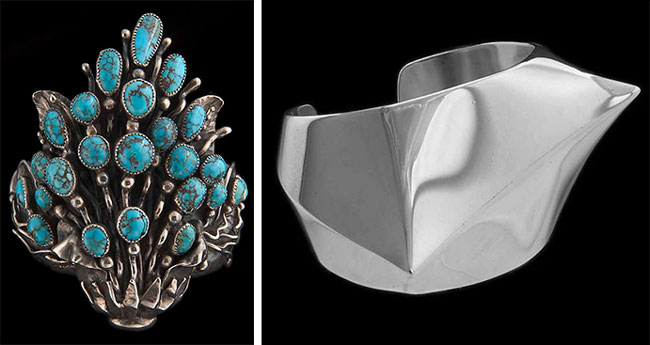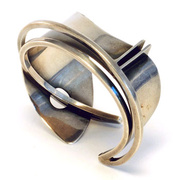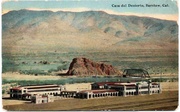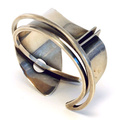
When picturing jewelry of the American Southwest, it’s easy to conjure a cliché of silver-and-turquoise bolo ties and squash-blossom necklaces. But it’s unlikely this fantasy includes the work of the Patanias, a family of Italian-American entrepreneurs who helped make the region famous for its bold jewelry. Since the 1920s, when first-generation immigrant Frank Patania arrived with his old-world techniques and adapted them to local tastes and materials, the Patania family has been an influential force in the area’s creative community. Frank opened his original Thunderbird Shop in Santa Fe, New Mexico, just as outside interest in the area began to spread, and the Patanias would eventually achieve broad recognition for their distinctive wearable art—work that was inspired by Native American jewelry but executed by the hands of a traditional Italian goldsmith.
“He brought an outsider’s design sensibility and work style that didn’t exist in the Southwest.”
Following in the footsteps of their patriarch, three subsequent generations of the Patania family have created striking jewelry influenced by a blend of European and Native American traditions. Their work has been beloved by celebrities and recognized by the Smithsonian, with Frank Sr., his son Frank Jr., and his grandson Sam Patania each represented in the collection of the Renwick Gallery at the Smithsonian American Art Museum. Today, Sam and his son, Marco, continue the family legacy at their shop, Patania Sterling Silver Originals, in Tucson, Arizona. Although Frank Sr. passed away when Sam was still a child, some of his innovative designs live on, now formed by the hands of his grandson.
Born in 1899, Frank Patania, Sr., began apprenticing in the goldsmithing trade in Sicily around the age of 6. When his hometown of Messina was hit by a major earthquake in 1908, the Italian government helped Frank’s family emigrate to the United States, where they settled in New York City. After waiting a few years to reach the legal working age of 14, Frank took a job with an upholsterer making tassels for furniture, though he soon moved into the jewelry business he was originally trained for.

Above: Left, the Floral Spray bracelet by Frank Sr., circa 1950, and the Asymmetry bracelet by Frank Jr., circa 1960, are both in Smithsonian collection. Via the Smithsonian American Art Museum.
“Frank Sr. started at a jewelry company named Goldsmith, Stern & Company in Manhattan where he was recognized as a designer while still in his teens and early 20s,” Sam Patania explains. “He was a beloved employee.” After Frank Sr. was diagnosed with tuberculosis, the company’s owner sent him to Santa Fe to recover, and he soon fell in love with the high-desert region. Following a stint working for Julius Gans’ Native American jewelry and craft store, Frank Sr. opened his first business, the Thunderbird Shop, next to the Santa Fe Railway ticket office on the town’s famous plaza in 1927. In addition to Patania’s original jewelry designs, the store also featured artwork and crafts by Native Americans as well as imported products from Italy and other countries.

The Thunderbird Curios Shop in Tucson, seen to the right of the Fox Theater marquee, opened in 1937.
In the 1930s, after marrying Aurora Massaco, a fellow Italian immigrant, and starting a family together, Frank Sr. began looking for an additional winter market, which brought him to Tucson, Arizona. “He ran stores and workshops in both Tucson and Santa Fe for the rest of his life,” Patania says, “packing up the family and moving between the cities to follow the seasons.”
As Patania explains, Frank Sr. was the sole designer for the Thunderbird Shop, though he employed several craftsmen to produce jewelry at his workshops in Santa Fe and Tucson, often hiring Native American jewelers. Many eventually became established artists in their own right, including Julian Lovato of the Santo Domingo pueblo in New Mexico; Arthur and Andy Rivera, who owned a shop across from the La Fonda Hotel in Santa Fe; and Alberto Contreras in Tucson.

Frank Sr., left, circa 1950s and Frank Jr., right, circa 1960s.
However, Frank Sr.’s designs stood out among the more familiar shapes of Native American jewelry, and in turn, his work influenced many artisans in the area. “He brought with him an Italian design sense, and worked silver in a gold and platinum style that made his pieces more sculptural and lighter in appearance than what was being done by Native Americans at the time,” Patania says. “His designs brought in clients who lived in the area part time and wanted jewelry that could be worn outside the Southwest.”

A coral and silver necklace by Frank Sr. from around 1955.
Although Frank Sr. did incorporate regional materials like silver and turquoise, as well as common motifs of Native American jewelry, his style blended these with European trends, such as the organic forms of Art Nouveau and the streamlined shapes of Art Deco. “Many of his motifs, like leaves, are not traditionally Native American, but they became ubiquitous in Native American work after he began using them,” Patania explains. “He brought an outsider’s design sensibility and work style that didn’t exist in the Southwest until he moved to Santa Fe in the early 1920s.”
The Thunderbird Shop also benefited from the expansion of Fred Harvey’s tourist company, which brought thousands of outsiders to the region, many looking for “authentic” souvenirs. Frank Sr. made jewelry for some of the company’s famous Harvey Girls as well as members of the Santa Fe creative community, including Mable Dodge Luhan and Georgia O’Keeffe. “His designs weren’t so regional, meaning his work could be worn with a wonderful fashionable impact in Manhattan, Chicago, or Kansas City,” Patania says.

The Original Thunderbird Shop’s letterhead, circa 1930s.
Frank Sr.’s emblematic work often included smooth expanses of open silverwork, stone clusters utilizing expensive sets of calibrated turquoise, and spiraling scrolls or other natural shapes like vines and leaves, similar to his Floral Spray cuff in the Smithsonian collection. His hybrid approach became known as the “Patania Thunderbird” style—a look that sometimes relied on Native American motifs, but with a twist. “He did overlay work unlike anything that was being done at the time,” Patania continues, “and would often do stamp work on top of this overlay, like using Native American-style stamps made by his craftsmen.”
Frank Sr. hit his stride in the 1940s and ’50s, after the country had recovered from the Great Depression and World War II. “He seemed able to express himself more often in his work, and he produced a large volume of art pieces during that time,” Patania says. “Many of Frank Sr.’s key craftsmen went off to fight during World War II, so production was greatly limited at that time, but the 1950s were a renaissance for him.”

This 1958 article showed Frank Sr. in the workshop with his son and other jewelry craftsmen.
By this time, Frank Sr. was able to afford more employees, machinery, and fine materials, like coral procured in his native Italy. He worked like a traditional studio master, where his most trusted craftsmen would make parts that he would assemble into a final piece. “There was simply more money and larger market for damn near everything during the 1950s,” Patania says. Around the same time, his son, Frank Patania, Jr., returned to the family jewelry business after completing college and his service in the U.S. military. Frank Jr. quickly developed his own aesthetic, which was influenced by the simpler geometric forms of Mid-Century Modern design.
“My dad distinguished himself by creating what he calls his ‘architectural style,’ which was influenced by architecture he had seen,” Patania explains. “He was a journeyman silversmith by the time he was in high school, meaning he had completed his apprenticeship with a master, so he had a big advantage in being able to sit down and work without worrying about technique. But like many artists, he pushed himself beyond what he was comfortable with and went into areas he wasn’t trained for.” Frank Jr.’s time at the University of Arizona had opened his eyes to a range of arts and media far beyond his jewelry apprenticeship, and his more contemporary designs were soon winning awards and achieving recognition in exhibitions on modernist jewelry.
“My dad was a man to whom handwork was the highest importance,” Patania adds. “Although he had Thunderbird-style designs cast for him, all his artwork was completely made by his own hand.”
Though Frank Sr. passed away in 1964, Frank Jr. would pass on the family legacy to his son, Sam Patania, who was also raised in the jewelry business. Though they never worked together, Patania still produces some of his grandfather’s most popular pieces. “I do make Frank Sr.’s and Jr.’s designs in what I call the ‘Patania Collection,’ which are bestseller designs,” Patania says, “such as the Georgia bracelet named after Georgia O’Keeffe, who was a friend of my grandfather’s. She was photographed wearing his cuff bracelet by Alfred Stieglitz, and I still make that cuff.”

Georgia O’Keeffe wears a bracelet designed by Frank Patania, Sr., in this 1933 photo by Alfred Stieglitz. Via the Metropolitan Museum of Art.
Today, Patania has integrated new technologies into the family business that shorten the time to produce jewelry and increase output, while still allowing for pieces to be finished by hand. “Starting in the late 1990s with the advent of hydraulic presses for jewelry, the use of urethane—for either the punch or the die—changed everything,” Patania says. “Now, these can be made easily and cheaply out of Delrin or Plexiglass with the opposing punch or die being made of urethane, which takes whatever shape it’s pushed into. By using urethane, the amount of handwork required to finish a piece is much reduced because urethane leaves little or no tool marks.” Along with the help of his son, Marco, Patania uses the hydraulic press to make as much jewelry as a room full of craftsmen, without sacrificing quality.

Sam Patania’s Tension bracelet, from 1999, was acquired by the Smithsonian. Via the Smithsonian American Art Museum.
In 1999, the Patanias’ work was showcased in a three-generation show at the Tucson Museum of Art and the curator in charge, Joanne Stuhr, brought their work to the attention of a curator at the Renwick Gallery of the Smithsonian Institute, Kenneth Trapp. Trapp thought it was important enough to include in the Smithsonian’s permanent collection, so pieces by Frank Sr., Frank Jr., and Sam Patania were all acquired.
Patania says his personal design sensibility is strongly influenced by his father and grandfather’s work, as well as modernist jewelry from the 1950s, Mexican jewelry, and the offerings of the Tucson Gem show. “I have many things to inspire me,” he says. “The Golden Age of Santa Fe is in my bones. I love working with gold, platinum, gemstones, and rare turquoise. But I would have to leave the description of my style to others—I’m too close to it to see it.”

Sam Patania in his studio.





















 Jewelry as Sculpture: The Birth of Modernist Studio Jewelry
Jewelry as Sculpture: The Birth of Modernist Studio Jewelry
 Why the 'Native' Fashion Trend Is Pissing Off Real Native Americans
Why the 'Native' Fashion Trend Is Pissing Off Real Native Americans Jewelry as Sculpture: The Birth of Modernist Studio Jewelry
Jewelry as Sculpture: The Birth of Modernist Studio Jewelry Railway Paradise: How a Fine-Dining Empire Made the Southwest Palatable to Outsiders
Railway Paradise: How a Fine-Dining Empire Made the Southwest Palatable to Outsiders Native American JewelryWhile the tradition of making jewelry out of shells and beads dates to preh…
Native American JewelryWhile the tradition of making jewelry out of shells and beads dates to preh… Sterling Silver JewelryLike the moon it’s been associated with for millennia, silver reflects the …
Sterling Silver JewelryLike the moon it’s been associated with for millennia, silver reflects the … Mari Tepper: Laying it on the Line
Mari Tepper: Laying it on the Line Nice Ice: Valerie Hammond on the Genteel Charm of Vintage Canadian Costume Jewelry
Nice Ice: Valerie Hammond on the Genteel Charm of Vintage Canadian Costume Jewelry How Jim Heimann Got Crazy for California Architecture
How Jim Heimann Got Crazy for California Architecture Modernist Man: Jock Peters May Be the Most Influential Architect You've Never Heard Of
Modernist Man: Jock Peters May Be the Most Influential Architect You've Never Heard Of Meet Cute: Were Kokeshi Dolls the Models for Hello Kitty, Pokemon, and Be@rbrick?
Meet Cute: Were Kokeshi Dolls the Models for Hello Kitty, Pokemon, and Be@rbrick? When the King of Comedy Posters Set His Surreal Sights on the World of Rock 'n' Roll
When the King of Comedy Posters Set His Surreal Sights on the World of Rock 'n' Roll How One Artist Makes New Art From Old Coloring Books and Found Photos
How One Artist Makes New Art From Old Coloring Books and Found Photos Say Cheese! How Bad Photography Has Changed Our Definition of Good Pictures
Say Cheese! How Bad Photography Has Changed Our Definition of Good Pictures Middle Earthenware: One Family's Quest to Reclaim Its Place in British Pottery History
Middle Earthenware: One Family's Quest to Reclaim Its Place in British Pottery History Fancy Fowl: How an Evil Sea Captain and a Beloved Queen Made the World Crave KFC
Fancy Fowl: How an Evil Sea Captain and a Beloved Queen Made the World Crave KFC
I love south western jewelry. This article was a fun read. Thank for sharing.
This is wonderful place to study jewerly or other subjects you have an interest in. I love all the artists that made southwester jewerly and the artists in Taxco. Thank you for making this wonderful imformation available to people who love the beautiful Art of Jewerly.